Dinghy Repair Cleaning
Go To: Sailing - Dinghy Repair
Posted on 15 May 2008 18:28
Cleaning a bot can be a boring job - but not only can you make your boat sparkle and be proud of it, but it's easier to spot damage that needs repairing.
How many times do you say "we really need to clean this boat?" How many times do you really mean it? How often do you do it...
This Laser 2 was in need of a clean. The previous owner had looked after it, but being winter, not having been sailed for a few months, it needed a clean before we could really assess all of the repairs we needed to do.
Covers are so often the part of a boat that gets the dirtiest, since they are exposed to the elements (see Photo 1), but are often the easiest to clean. A bucket of soapy water and a small handbrush are all you need.
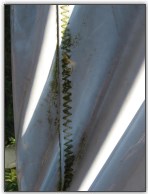
Photo 1. Cleaning The Cover
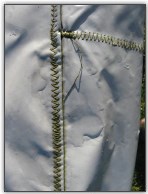
Photo 2. Cleaning The Cover
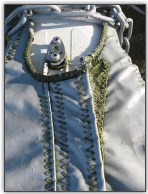
Photo 3. Cleaning The Cover
The two main types of dirt you'll commonly find on a dinghy cover are general dirt over the fabric, and lichen build up around the stitches (see Photos 2 and 3) - both of which soapy water and a bit of elbow grease will solve. All you've got to do is scrub (see Photos 4, 5, 6 and 7)! Be careful with older covers however, if you scrub too hard the cotton stitches may have reached the point where they will break apart, and you don't want to make your cover fall apart. Be more gentle if this is the case - a sponge will work just as well.
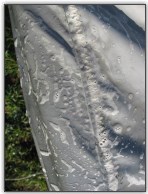
Photo 4. Cleaning The Cover
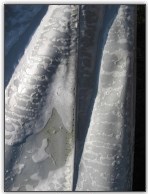
Photo 5. Cleaning The Cover
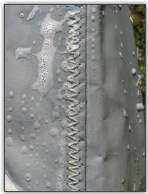
Photo 6. An almost clean cover!
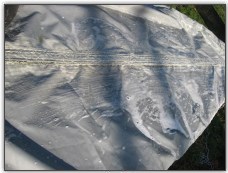
Photo 7. A cleaner cover
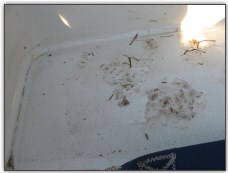
Photo 8. A dirty cockpit
Once the cover is done, then we move onto inside the boat. It's a bit dirty inside, with accumulated sand and grit in the cockpit and around the self-bailer and toe straps, and collected grime around edges and hollows all over the boat. A sponge is often the best tool, although if you've got ingrained dirt, we recommend the brush once again. Also, if there are small areas to clean, such as around deck fittings, an old toothbrush is very handy.
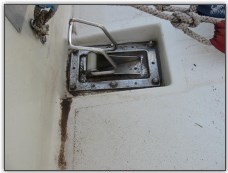
Photo 9. A dirty self drainer
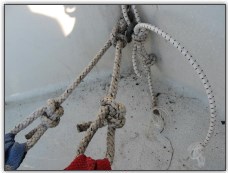
Photo 10. Nasty toestraps
Our spars are pretty dirty, and they're going to get some in depth treatment with a toothbrush and some metal cleaning solution. Unfortunately there's not much you can do with old damaged spars - aluminium spars are anodised; that means their covering was put on with a chemical process, and no cleaning solutions are going to fix it where it's rubbed off. Hammerite is also not recommended for painting boat spars, due to the use they get - the paint will end up falling off inside the boat. We'll revisit the spars (the mast and boom) in a later article.
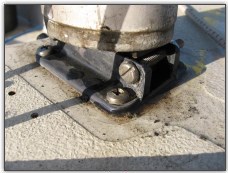
Photo 11. Dirty mast foot
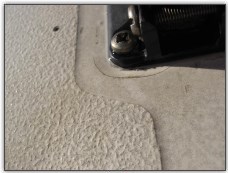
Photo 12. Clean mast foot
We can't really say much else without starting to sound patronising - it's not difficult to figure out how to clean a boat. But, if you need to do some work to it, it's best to start out with it as clean as you can get it, so you can properly see what you're doing. You'll be surprised just how many gelcote chips, scratches, dents and other pieces of damage you'll uncover when giving a boat a really good clean.

Photo 13. Clean cockpit
For any cleaning, use general purpose cleaner such as washing up liquid or cif, and rinse of well away from the waters edge so nature is not harmed. Try not to allow any runoff into lakes, rivers etc. If you have to use any nastier chemicals, such as acetone or white spirits, make sure you don't spill any, wipe up any spills that do occur, and safely dispose of any rags or tissue that is used to wipe it up.
Summary
Cleaning a boat can be an arduous and boring task - but it should be done. Not only should you clean the boat, but you should keep the sails clean (clean off any mud), keep your spars clean, make sure any tracks are free from obstructions, and especially keep your blocks and ropes clean. Ropes can be thrown in the washing machine to clean them (unless they're spliced on, shackles don't do much good to the inside of a washing machine), and dust and dirt should be cleaned out of blocks, to make sure they continue to work well.
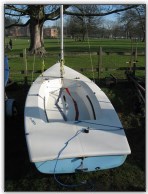
Photo 14. A Nice clean boat
Clean your boat regularly - and it shouldn't get to the stage where it's very difficult to do.